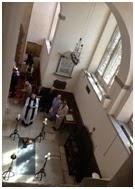Worship in Mozambique
Gordon and Elaine Brown reflect on the second week of their sabbatical journey
Our first Mozambican worship experience, the introduction and welcome of Pastor
Ernesto Langa and family to his new congregation, was a mix of formal
statements, a serious charge and the friendly banter of greetings to which we
were invited to contribute.
Instructed to join the processing Presbytery dignitaries, we were
led to the dais and seated on either side of our interpreter. Singing seemed to
start unannounced from different parts of the church and was taken up all
round, unaccompanied and without two people starting different songs. It was
tantalising to hear a familiar tune yet find our familiar words deserted us as
words in the local Ronga language or Portuguese were sung. Hymn books were
solfa style and even though many people had no book, they were singing in
harmony, the women often ululating to express joy. The men showed their joy in
exuberant dancing.
More dancing as members were called out by zone or elder's group to bring their tithes, it being first Sunday of month.
Visitors were also invited to participate with offerings, and dance, but we had no local currency
at the time. I'd have had two opportunities as all who'd had a January birthday were
congratulated, on giving another donation!
Various choirs performed. The Women's group, dressed in their
uniform for this special service, pulled Argentina, Ernesto's wife into their
midst in welcome.
Worship over, we processed out and lined up to shake hands with
congregation.
Worship at the retreat felt more intimate as the common purpose
was the focus, but there was still singing with gusto, led by one Presbytery
President thumping the beat on a leather-covered Bible.
Attending Saturday's wedding was a different worship experience. Once more placed up front, we had only photographers between us
and the proceedings. Bride and groom, very solemn, were from two
different denominations, so choir and congregation were vying to sing, and
seeking to find a hymn known to all. Pastor Marcus smoothed things by engaging
everyone in repartee as he gave his sermon, then led the dancing as he signed
the register.
Smiles all round however once the certificate and couple were
photographed. Two elderly elders took over and directed presentation of gifts
to the bride, efficiently whisked from her and displayed while the giver made a
speech dispensing advice. A length of traditional cloth, symbolically wrapped
the two together before gift-wrapped boxes, pans, and crockery appeared. Then,
through a side door was carried a double bed, mattress and bed linen. Both sides
swarmed to dress the bed and the couple were seated on it for more photographs.
Pastor Marcus played the Wedding March on a portable keyboard and we slipped
out, leaving the party to their wedding breakfast.
Sunday's services were no less musical. We walked to the Synod
compound for 7am worship in English, led by a young woman elder reading the set
liturgy, each part followed by a relevant hymn. People were invited to contribute news, prayer
or song, one child took
the offering and said the
prayer of dedication, another played a saxophone then we were invited to
give greetings before Gordon preached. After-worship breakfast arrangements had
fallen through but gave opportunity to chat with those present.
 |
| Elaine preaching, with her interpreter, Estrela |
Later we were driven to a church in the suburbs where it was my
turn to preach, a translator by my side. The Sunday school came to remind
families of the new session commencing and to bring their children. They gave
an enthusiastic example of their songs, and dancing of course, and welcomed the
new Youth Worker. Later one young girl stole the show by marching confidently
to stand before the congregation to thank everyone for "being like Father
and Mother to me, teaching me about God". She was a hard act to follow but
the choirs gave it their best.
We were instructed in moving to the rhythm of the hymns and had
the chance to show what we'd learned as the offerings were taken up. And there
was more dancing as we lined up to shake hands. Altogether a joy-filled time of
worship.
Office prayers again was an intimate time of sharing both the
synod's vision and personal needs. What will next Sunday bring?














